Remembrance of the "Grand Lecture Hall" atop the hill of Mita -The much lamented passing of magnificent Gothic architecture-
Opened in 1915 in pursuit of a larger speaking hall
Completed in 1915, the Grand Lecture Hall engendered an academic atmosphere together with the Keio University Library (old building), both symbolic Buildings of the University.
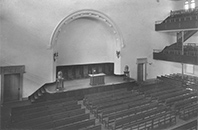
The seating capacity of the Hall was about 2,000 people. Including standing capacity, it could accommodate about 2,500 people, its scale said to be one of the largest in Tokyo. At the Hall's opening ceremony on June 6, 1915, then Keio University President Eikichi Kamata expressed his great joy at its completion, mentioning the tradition of the Mita Public Speaking Event founded by Yukichi Fukuzawa and the insufficient capacity of its venue, the Mita Public Speaking Hall (Mita Enzetsu-kan), which could only hold a few hundred.
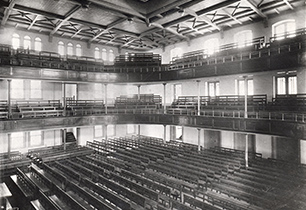
The building was designed by Sone Chujo Architectural Office, who also designed the Keio University Library (old building). The construction cost of seventy thousand yen was covered by donations, of which twenty thousand yen was donated by Momosuke Fukuzawa and fifty thousand by Morimura Homei Society. Keio University covered the cost for fixtures, a cost of fifteen thousand yen.
The aforementioned Momosuke Fukuzawa was a successful entrepreneur in many fields, including an electric power business, and the adopted son-in-law of Yukichi Fukuzawa. Ichizaemon Morimura, who made the donation under the Morimura Homei Society (above), was a businessman who appreciated Yukichi Fukuzawa’s beliefs and became a pioneer in trading, establishing longstanding companies such as Morimura Gumi, which later became Morimura Bros., Nippon Toki Kaisha, Ltd. (presently Noritake) and Toyo Toki Co., Ltd. (presently TOTO).
Prominent historical figures who spoke in the Grand Lecture Hall
In an area adjacent to the Keio University Library (old building) called "Bungaku no Oka", or the “Hill of Literature” in English, there is a stone monument with an engraving which states: “Raindrops are falling on the red brick wall of the Grand Lecture Hall.” Keio graduate Mantaro Kubota, writer and haiku poet, wrote this poem in memory of the late Kaoru Osanai, who taught at Keio University and gave lectures at the Grand Lecture Hall. The author associates the grief of loss with a picture of the rain-speckled red bricks of the Grand Lecture Hall.
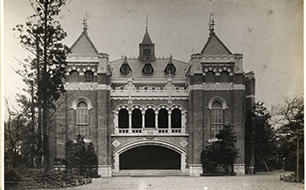
At the Grand Lecture Hall, not only Kaoru Osanai but also people such as Ryunosuke Akutagawa and Takeo Arishima Spoke to the audience that filled the hall. Cultural figures from overseas such as Tagore, an Indian poet who became the first Asian to win the Nobel Prize, and physicist Einstein also delivered lectures here, just to name a few.
In 1932, the 75th anniversary commemorative ceremony of Keio University was held at the Grand Lecture Hall, and then Prime Minister Tsuyoshi Inukai, who had previously studied at Keio University, attended the ceremony. Only 6 days later was he gunned down in the May 15 Incident.
A pair of statues installed after the earthquake
Wartime damage marks the end of the building
The Grand Lecture Hall was severely damaged by the Great Kanto Earthquake in 1923. During reparation, major renovations were made to the entrance, and at the same time, a pair of unicorn statues was placed on the balcony of the third floor. The pair's grotesque yet surprisingly lovable look seems to have gained popularity among faculty members, staff, and students alike. However, it is till a mystery where they came from and why they were placed there.
In May 1945, just months before the end of the Pacific War, the destruction reached Mita. The damage caused by the air raids was extensive and the interior was completely burned down. With only the exterior wall remaining, the majestic Grand Lecture Hall now looked miserable. Even after the war, it remained there for more than ten years in hopes of renovation, but in 1957, it was finally torn down for construction of the West School Building.
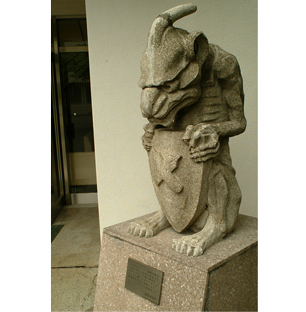
One statue was repaired and the other replicated. The pair now sit outside Keio Chutobu Junior High School
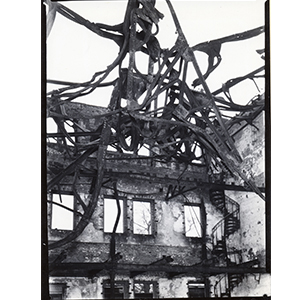
air raids on Tokyo
Yukichi Fukuzawa rides on horseback to the Foreign Ministry to collect money
-From Ichizaemon Morimura’s congratulatory speech at the completion ceremony of the Grand Lecture Hall-
Ichizaemon Morimura shared the following story in his congratulatory speech at the completion ceremony of the Grand Lecture Hall. On the eve of the Meiji Restoration, when Morimura consulted Yukichi Fukuzawa about wanting to make the country prosperous through foreign trade, he was encouraged by Fukuzawa, who said, “People are making a fuss about war and politics, but today’s most important and urgent matter is foreign trade.” After Morimura started his trade business, he asked for Fukuzawa’s advice because he had trouble sending money from an overseas country to Japan in a time when there was no foreign exchange. Fukuzawa made arrangements to deposit the sales into the Japanese legation or the consulate of the country, and then to submit the receipt at the Foreign Ministry to receive the money. And when Morimura handed Fukuzawa the receipt, he quickly rode to the Foreign Ministry on horseback and came back with the money. This episode helps us vividly picture the actual situation of foreign trade during its first days in the early Meiji era while conjuring up an image of Yukichi Fukuzawa on horseback.
*Photographs used in the article are preserved by the Fukuzawa Memorial Center for Modern Japanese Studies.
